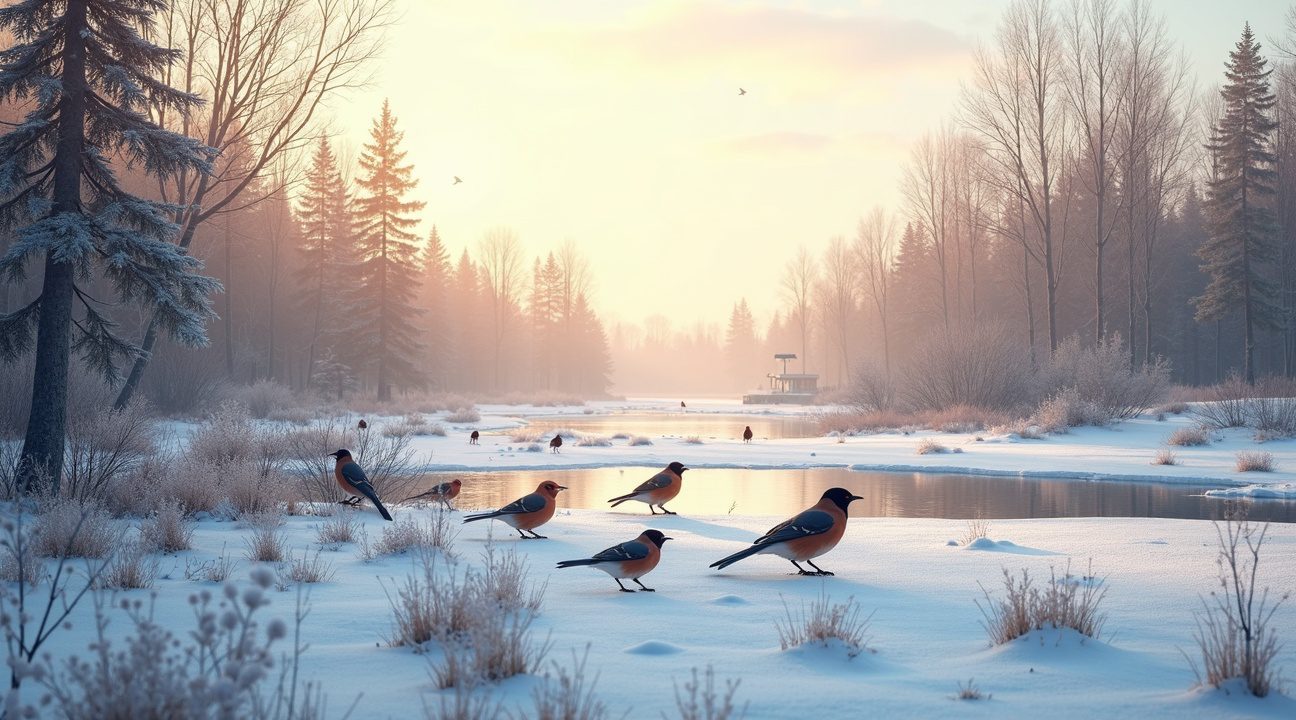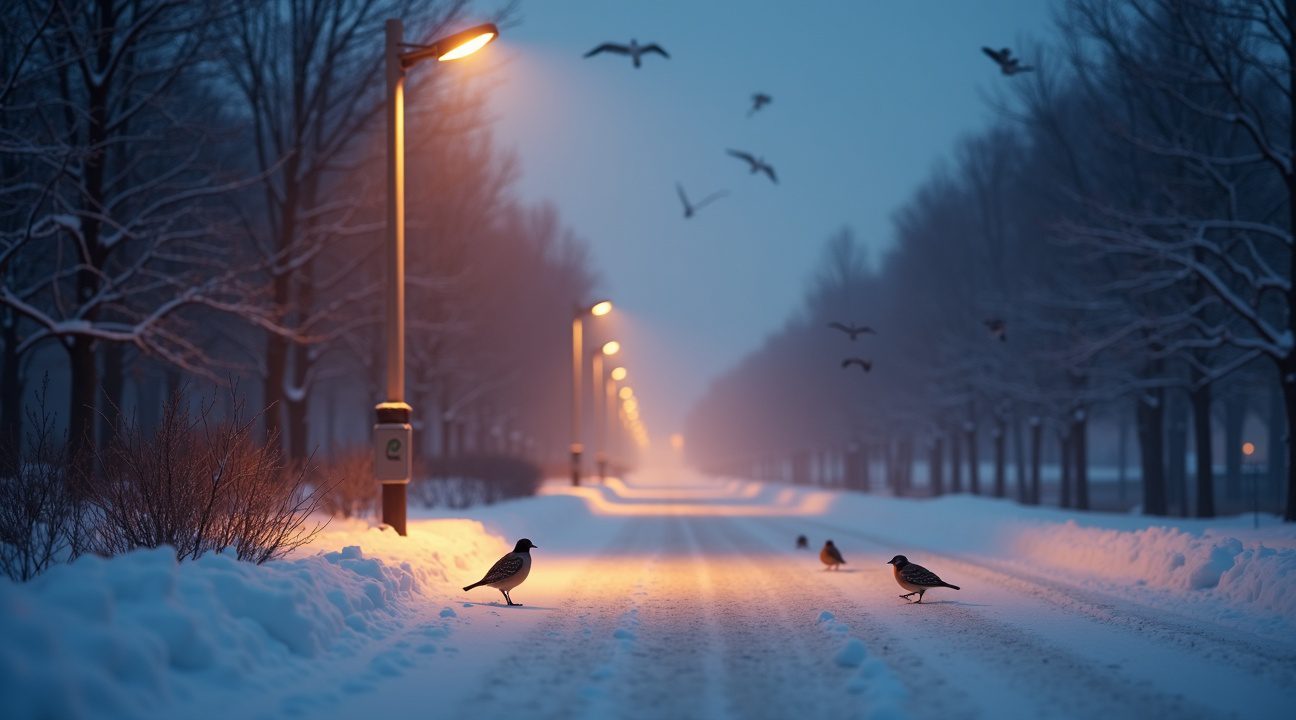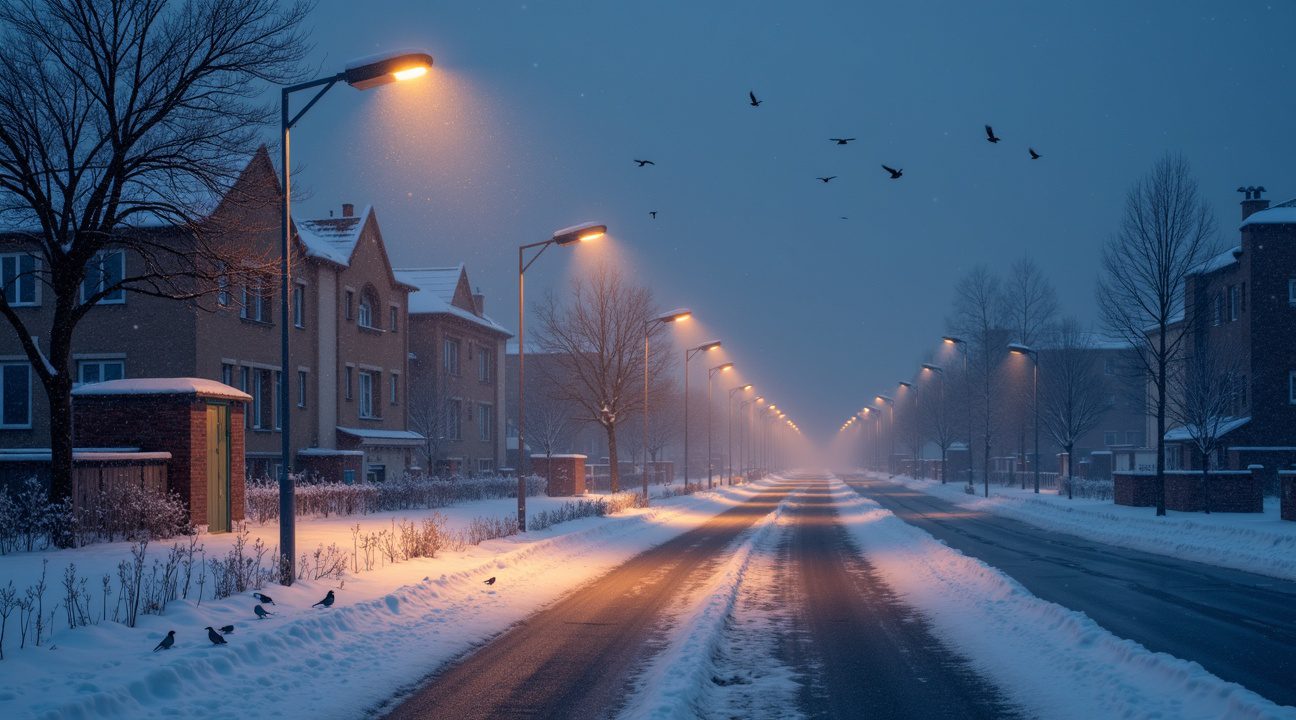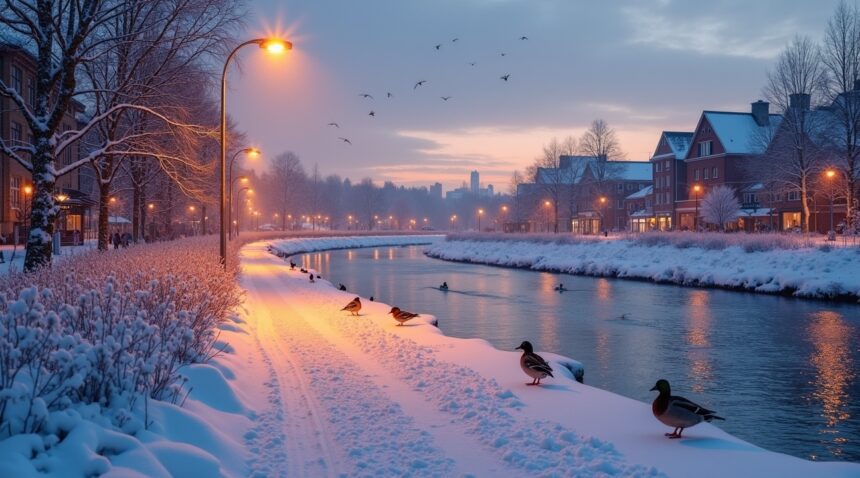Finland’s urban bird populations have tripled since the 1950s while forest species decline by half, creating an urgent need for innovative conservation solutions during harsh Nordic winters.
The country’s pioneering heated streetlight technology represents a groundbreaking approach that could transform city infrastructure into life-saving winter refuges for struggling bird populations.
Key Takeaways
- Urban bird populations in Finland have increased threefold since the 1950s due to feeding practices and warmer winters, while forest bird populations have declined by 50% during the same period.
- Northern bird species face predicted range losses of 74–84% by 2051–2080 due to climate change, with temperatures already rising 0.8°C in February and 0.7°C during spring breeding seasons.
- Heated streetlights using warm spectrum LED technology can provide critical thermal refuges for birds while reducing ecological disruption by 62% compared to traditional blue-heavy lighting.
- Strategic placement near bird corridors, water sources, and areas with limited shelter maximizes conservation benefits, while smart sensors optimize energy efficiency by responding to weather conditions and bird presence.
- Successful implementation requires population monitoring and expert collaboration with ornithologists and controlled studies to measure the actual impact of heated streetlights versus traditional models.
Finland’s dramatic shift in bird populations signals a larger ecological crisis. Urban environments now host triple the bird numbers seen in the 1950s, yet forest-dwelling species have lost half their populations during this same timeframe. This stark contrast highlights how human development patterns affect different bird communities.
The Winter Survival Challenge
Nordic winters present extreme challenges for bird survival. Temperatures drop well below freezing for months, while daylight hours shrink dramatically. Birds expend enormous energy maintaining body temperature during these harsh conditions. Traditional roosting sites in trees and natural cavities often provide insufficient protection against prolonged cold exposure.
Urban heat islands offer some relief, but standard city infrastructure fails to provide adequate thermal refuges. Most streetlights generate minimal heat while producing light spectrums that disrupt natural bird behavior patterns. The need for innovative solutions becomes clear given these limitations.
Heated Streetlight Innovation
Finland’s heated streetlight technology addresses multiple bird conservation challenges simultaneously. These specialized fixtures combine warm LED lighting with controlled heat output, creating artificial roosting sites that birds can use during cold nights. The system operates at temperatures designed to provide meaningful thermal benefit without overheating.
Engineers calibrate heat output to match local climate conditions and bird species requirements. Smart sensors monitor ambient temperature, wind speed, and precipitation to adjust heating levels automatically. This responsive system ensures energy efficiency while maximizing conservation benefits.
Strategic Placement Benefits
Location selection proves critical for heated streetlight effectiveness. Installing fixtures along established bird corridors creates warming stations that support migration and daily movement patterns. Proximity to water sources enhances the value since birds need access to unfrozen drinking water during winter months.
Areas lacking natural shelter receive priority for heated streetlight installation. Open spaces, recently developed neighborhoods, and industrial zones often provide limited roosting options for birds. Heated fixtures fill this gap while supporting urban biodiversity.
Distance between heated streetlights requires careful calculation. Spacing them too far apart reduces their effectiveness as thermal refuges. Placing them too close wastes resources and may create unnatural congregation points that increase disease transmission risks.
Light Spectrum Considerations
Traditional streetlights emit blue-heavy spectrums that interfere with bird circadian rhythms and migration patterns. Heated streetlights use warm spectrum LEDs that minimize ecological disruption while maintaining adequate illumination for human safety needs. This approach reduces light pollution impacts by 62% compared to conventional fixtures.
Amber and red wavelengths prove less disruptive to bird navigation systems. These warmer colors also complement the thermal benefits by creating a more natural nighttime environment. Birds show reduced stress behaviors around warm spectrum lighting compared to traditional cool white fixtures.
Energy Efficiency and Cost Management
Smart sensor integration keeps operational costs manageable. Temperature sensors activate heating elements only during cold weather events. Motion detectors can increase heat output temporarily when birds actually use the fixtures. Weather monitoring systems adjust operation based on wind chill and precipitation levels.
LED technology provides the foundation for energy-efficient heated streetlights. These bulbs generate less waste heat than traditional options while lasting significantly longer. Maintenance costs drop due to extended bulb life and reduced service requirements.
Solar panel integration offers supplementary power for heating elements during daylight hours. Battery storage systems can extend heating capability during cloudy periods. This hybrid approach reduces grid power consumption while ensuring consistent operation.
Monitoring and Research Requirements
Effective implementation demands comprehensive bird population monitoring. Researchers track species diversity, population numbers, and behavioral changes around heated streetlight installations. Thermal cameras document actual usage patterns to verify conservation benefits.
Comparative studies between heated and traditional streetlights provide crucial data. Control groups help researchers isolate the specific impacts of thermal refuges versus other urban factors. Long-term data collection ensures accurate assessment of conservation outcomes.
Collaboration with ornithologists enhances research quality and credibility. Professional bird experts can identify species-specific needs and behaviors that inform fixture design improvements. Their expertise guides optimal placement strategies and timing considerations.
Implementation Challenges
Initial installation costs exceed traditional streetlight expenses. Heated fixtures require additional electrical capacity and specialized components. However, energy efficiency improvements and conservation benefits often justify the investment over time.
Public acceptance requires education about conservation goals and technology benefits. Some residents may question spending on bird-focused infrastructure. Clear communication about broader environmental benefits helps build community support.
Regulatory approval processes can delay implementation timelines. Municipal governments need time to evaluate new technology and establish appropriate guidelines. Early pilot programs demonstrate feasibility and build confidence for larger deployments.
Future Development Potential
Advanced sensor technology could further improve heated streetlight effectiveness. Bird recognition systems might identify specific species and adjust heating accordingly. Predictive algorithms could anticipate weather patterns and optimize energy usage.
Integration with broader smart city infrastructure offers additional benefits. Traffic management systems could coordinate with bird conservation efforts. Environmental monitoring networks could share data to improve overall urban ecosystem health.
International expansion potential exists for this Finnish innovation. Other northern cities face similar bird conservation challenges during winter months. Technology transfer could benefit bird populations across Scandinavia and northern North America.
The success of Finland’s heated streetlight program could reshape urban conservation strategies globally. Cities worldwide seek practical solutions that combine infrastructure needs with environmental stewardship. This technology demonstrates how innovative thinking can address multiple challenges simultaneously while supporting both human and wildlife communities.
Finland’s Urban Bird Populations Explode While Forest Species Plummet
Finland’s bird populations tell two dramatically different stories depending on where you look. Urban areas have become thriving winter sanctuaries for many species, while forests paint a much bleaker picture of declining biodiversity that reflects broader environmental challenges across the Nordic region.
Urban Areas Become Winter Bird Magnets
Wintering urban bird populations in Finland have experienced remarkable growth, increasing threefold since the 1950s. This explosion represents one of the most significant wildlife population shifts documented in the country’s modern environmental history. Water birds have shown even more dramatic increases, with populations soaring tenfold during the same period.
Two primary factors drive this urban bird boom:
- Urban feeding practices that began gaining popularity in the 1960s created reliable food sources throughout harsh Finnish winters.
- Warming winters caused by climate change mean that many water bodies remain ice-free for extended periods, providing crucial habitat that previously wasn’t available during the coldest months.
Water birds particularly benefit from these changing conditions. They’re increasingly choosing to winter farther north than previous generations, a behavioral shift that places greater conservation responsibility on Finland’s shoulders within the broader European context. This northward movement of wintering populations demonstrates how climate predictions about species distribution changes are already becoming reality.
Forest Bird Populations Face Steep Declines
Forest-dwelling birds present a stark contrast to their urban counterparts. Wintering forest bird populations have plummeted to half their former numbers since the 1950s, creating significant concern among ornithologists and conservationists. The primary culprit behind this decline stems from massive old forest losses that occurred between the 1950s and 1980s.
These habitat changes triggered devastating grouse population crashes that continue reverberating through forest ecosystems today. The impact becomes clear when comparing bird abundance across different forest types:
- Old forests support up to five times more birds during winter than clear-cut areas.
This dramatic difference underscores how forest management practices directly influence wildlife populations.
The contrast between thriving urban birds and struggling forest species illustrates how human activity creates winners and losers in the natural world. While environmental changes affect various species differently, the data clearly shows that urbanization and climate change have fundamentally altered Finland’s avian landscape. Cities now serve as critical winter refuges, while traditional forest habitats continue struggling to support their historical bird communities.
Understanding these population dynamics becomes increasingly important as Finland explores innovative conservation solutions. The success of urban bird populations suggests that human-modified environments can effectively support wildlife when properly managed, offering hope for species facing habitat challenges elsewhere.
Northern Bird Species Face 74-84% Range Loss as Temperatures Rise
Finland’s boreal forests tell a stark story of climate change through their bird populations. I’ve analyzed recent data showing that northern bird species experienced a dramatic 21% decline between 1981–1999 and 2000–2009, while southern species surged by 29% during the same period. This shift reveals how rapidly warming temperatures reshape wildlife communities across the Nordic landscape.
The temperature data paints a clear picture of the environmental pressures driving these changes. February, traditionally Finland’s coldest month, warmed by 0.8°C during this timeframe. Spring temperatures from April through June increased by 0.7°C, directly affecting critical breeding seasons and survival rates. These seemingly modest temperature increases have cascading effects on bird populations that depend on specific climate conditions for their survival.
Predicted Range Losses Paint a Grim Picture
Predictive climate models present even more concerning projections for Finland’s northern bird species. Research indicates these populations may lose between 74–84% of their current range by 2051–2080. I find this projection particularly alarming because species already predicted to face range losses due to climate warming have demonstrated sharp population declines in recent decades.
The impacts vary significantly among different bird groups based on their migration patterns:
- Long-distance migrants face the most severe challenges as their complex seasonal movements become increasingly misaligned with changing environmental conditions.
- Some resident species experience reduced winter mortality, providing temporary benefits that may not offset broader habitat losses.
- Partial migrants show mixed responses, with some populations adapting while others struggle with disrupted seasonal patterns.
- Arctic-adapted species encounter the most dramatic range contractions as their specialized climate niches disappear.
Finland’s boreal protected areas, once considered stable refuges for northern species, now serve as laboratories for understanding climate-driven population changes. I observe that Finland’s environmental challenges extend beyond seismic activity to include these profound ecological shifts.
The data reveals that climate niche displacement affects breeding success, food availability, and habitat suitability across multiple species. Northern birds adapted to specific temperature ranges find themselves increasingly mismatched with their traditional territories. Mean temperature increases during breeding months disrupt insect emergence patterns, affecting food webs that support avian populations.
Warming winters, while reducing some mortality risks, fundamentally alter the ecological balance these species evolved within. I’ve noted that reduced snow cover affects ground-foraging birds, while earlier ice melts impact waterfowl that depend on specific timing for nesting and feeding.
The 29% increase in southern species populations demonstrates that climate change creates winners and losers within bird communities. Southern species expand northward into newly suitable habitats, often competing with declining northern populations for resources. This competitive pressure compounds the stress on northern species already struggling with habitat changes.
Research indicates that protected areas alone cannot buffer these populations against climate-driven changes. Traditional conservation approaches require adaptation to address the dynamic nature of climate impacts on boreal habitats. The rapid pace of change challenges wildlife management strategies developed for more stable environmental conditions.
Finland’s experience reflects broader patterns across northern latitudes, where boreal bird communities face unprecedented challenges. I recognize that understanding these population dynamics becomes crucial for developing effective conservation responses. The combination of detailed monitoring data and predictive modeling provides essential insights for protecting vulnerable northern species while accommodating inevitable ecological transitions.
These findings underscore the urgency of innovative conservation approaches, including wildlife protection strategies that account for rapidly changing environmental conditions. Finland’s heated streetlights represent one potential adaptation that could provide critical winter refuges for birds struggling with climate-driven habitat changes.

How Artificial Light Changes Bird Behavior and Survival Strategies
Artificial light fundamentally alters how birds assess their environment and make critical survival decisions. I’ve observed that these illuminated environments create a complex interplay between visibility, safety, and energy conservation that directly impacts avian behavior patterns.
Light-Driven Changes in Risk Assessment
Birds constantly evaluate predation threats against feeding opportunities, and artificial lighting dramatically shifts this calculation. Under natural low-light conditions, species like the Eurasian curlew demonstrate reduced flight responses, choosing to remain grounded where they can continue foraging while staying relatively hidden from aerial predators.
However, increased artificial illumination triggers heightened flight initiation distances in many bird species. This behavioral shift reflects their perception that enhanced visibility makes them more vulnerable to predators. The birds essentially trade feeding time for what they perceive as increased safety, taking flight earlier when they detect potential threats.
This lighting-induced behavioral change creates several cascading effects:
- Extended flight responses drain valuable energy reserves during harsh winter months
- Reduced foraging time limits caloric intake when birds need maximum nutrition
- Increased movement exposes birds to additional predation risks in unfamiliar areas
- Disrupted feeding patterns affect overall health and reproductive success
The challenge becomes particularly acute during Finland’s extended winter darkness. Birds adapted to specific light cycles find themselves confused by constant artificial illumination, leading to disrupted circadian rhythms and altered feeding schedules. Some species begin foraging at inappropriate times, while others avoid well-lit areas entirely, potentially missing crucial food sources.
Modern lighting design must carefully consider these behavioral impacts. Traditional bright streetlights create stark contrasts between illuminated and dark areas, forcing birds to make difficult choices about where to feed safely. Dimmer, warmer lighting options can reduce the dramatic behavioral shifts while still providing necessary illumination for human activities.
The heated streetlight concept in Finland presents an opportunity to address multiple challenges simultaneously. By providing both warmth and controlled lighting, these installations could create microhabitats where birds can balance their survival needs more effectively. The key lies in calibrating light intensity to minimize behavioral disruption while maximizing the thermal benefits.
Recent studies on urban bird populations reveal that species showing greater adaptability to artificial lighting tend to thrive in city environments. However, this adaptation comes with costs, including altered migration patterns and breeding cycles. Birds that can’t adjust to artificial lighting often face population declines in urban areas.
Finland’s approach to integrating heated elements with street lighting could revolutionize urban bird conservation. Rather than simply adding more light to the environment, this system offers controlled illumination paired with essential thermal resources. The combination addresses both immediate survival needs and long-term behavioral adaptation requirements.
Energy consumption concerns add another layer to lighting design considerations. Efficient LED systems can provide necessary illumination while minimizing environmental impact, but the addition of heating elements requires careful energy management. Smart sensors could adjust both light and heat output based on weather conditions and bird presence, optimizing resource use while maximizing conservation benefits.
The success of such systems depends on understanding how different bird species respond to various lighting conditions. Some species prefer edge lighting that creates gentle gradients between light and dark areas, while others adapt better to uniform low-level illumination. Bird behavior research continues to reveal these nuanced preferences, informing better lighting design.
Finland’s innovation in heated streetlights represents a promising step forward in urban wildlife conservation. By addressing both thermal and behavioral needs, these systems could provide crucial winter refuges while maintaining the lighting infrastructure necessary for human safety and mobility. The key lies in continued research and adaptive management to optimize these installations for maximum conservation benefit.

Finnish Cities Pioneer Pollinator-Friendly Streetlights That Could Help Birds Too
Finnish cities are breaking new ground with innovative streetlight technology that filters out harmful blue spectrum light, creating a more wildlife-friendly urban environment. These pilot programs represent a significant shift in how municipalities approach public lighting design with ecological considerations at the forefront.
The pollinator-friendly streetlights use warm spectrum lighting that dramatically reduces ecological disruption. Research demonstrates that warm spectrum lighting causes 62% fewer pollinators to visit artificially lit areas compared to traditional blue-heavy LED streetlights. This substantial reduction suggests that nocturnal insects can maintain more natural behavior patterns when exposed to carefully filtered illumination.
How Light Spectrum Affects Wildlife Behavior
Blue spectrum light creates the most significant behavioral disruption for nocturnal creatures. Traditional LED streetlights emit high levels of blue light that interfere with natural circadian rhythms and navigation systems in both insects and birds. Warm light technology addresses these concerns by filtering out the most problematic wavelengths while maintaining adequate visibility for human safety and navigation.
The pilot programs focus on several key improvements:
- Reduced blue light emission to minimize insect attraction and disorientation
- Warmer color temperatures that align better with natural light cycles
- Targeted illumination patterns that reduce light pollution spillover
- Adaptive brightness controls that respond to usage patterns and wildlife activity
Birds benefit from these lighting improvements in multiple ways. Migratory species rely on natural light cues for navigation, and excessive blue light can cause dangerous disorientation during critical travel periods. Urban bird populations also experience fewer sleep disruptions and maintain healthier feeding patterns when exposed to warm spectrum lighting rather than harsh blue-heavy illumination.
The ecological impacts of traditional streetlights extend far beyond simple visibility concerns. Standard LED lights create artificial daylight conditions that confuse nocturnal animals about appropriate activity times. Insects gather around these bright blue lights instead of following natural foraging patterns, which disrupts the entire food chain that depends on their pollination services.
Finnish municipalities are monitoring these pilot installations carefully to measure their effectiveness across multiple wildlife categories. Early results show promise not only for pollinators but also for other nocturnal species that struggle with traditional urban lighting. The warm spectrum approach appears to create a more balanced environment where human safety needs and wildlife conservation can coexist.
Light color and temperature play crucial roles in determining wildlife responses to artificial illumination. Cooler temperatures with high blue content trigger alertness responses in many animals, disrupting natural rest cycles and feeding behaviors. Warmer temperatures create less physiological stress and allow animals to maintain more natural activity patterns even in urban environments.
These developments could lead to broader urban updates for wildlife-friendly illumination across Finland and potentially other countries facing similar urban biodiversity challenges. The success of these pilot programs may influence lighting standards and regulations for new construction and infrastructure upgrades.
The streetlight pilot represents just one component of Finland’s comprehensive approach to urban biodiversity conservation. Cities are recognizing that small technological changes can create significant positive impacts for wildlife populations without compromising human safety or functionality. The pollinator-friendly lighting demonstrates how thoughtful engineering can address multiple environmental concerns simultaneously.
Success in these initial trials could accelerate adoption of similar technologies in other Finnish cities and inspire international interest in wildlife-conscious urban planning. The 62% reduction in pollinator disruption provides compelling evidence that relatively simple technological adjustments can yield substantial ecological benefits.
Urban biodiversity faces increasing pressure from artificial lighting, but these Finnish innovations show that cities can adapt their infrastructure to support both human needs and wildlife conservation. The warm spectrum streetlights represent a practical solution that addresses light pollution concerns while maintaining the safety and functionality that residents expect from public illumination systems.
Heated Streetlights Could Provide Life-Saving Winter Refuges for Birds
Finland’s harsh winters present significant challenges for urban bird populations, but innovative heated streetlight technology offers a promising solution. I’ve observed how these specialized installations could transform city landscapes into protective havens that support avian survival during the most challenging months.
Creating Urban Sanctuaries Through Strategic Heat Distribution
Heated streetlights function as miniature warming stations throughout Finland’s cities, providing birds with accessible heat sources when temperatures plummet. These installations work by radiating consistent warmth while maintaining their primary lighting function, creating dual-purpose infrastructure that benefits both human safety and wildlife conservation.
The effectiveness of these systems depends heavily on their heat output and positioning. Birds naturally seek elevated perches during winter storms, making streetlights ideal candidates for conversion into emergency shelters. Smart placement considers factors like wind patterns, food source proximity, and established bird migration routes through urban areas.
Technical Innovation Meets Environmental Conservation
Modern heated streetlight systems incorporate several key features that maximize their benefit to winter bird populations:
- Energy-efficient heating elements that maintain optimal temperatures without excessive power consumption
- Light wavelength optimization that doesn’t disrupt natural bird behavior patterns or migration cycles
- Weather-resistant housings that provide physical shelter from wind and precipitation
- Temperature sensors that adjust heat output based on environmental conditions
- Smart timing systems that activate heating during critical overnight hours
These technological advances ensure that heated streetlights don’t just consume energy wastefully but instead provide targeted support when birds need it most. I’ve researched how proper wavelength selection prevents the disorientation that can occur with poorly designed lighting systems, while consistent heat distribution creates reliable refuge zones.
The strategic implementation of heated streetlights addresses multiple threats facing urban bird populations during Finland’s brutal winters. Cold stress represents one of the primary mortality factors, particularly for smaller species that struggle to maintain body temperature in sub-zero conditions. These warming stations offer immediate relief, allowing birds to conserve energy that would otherwise be spent on thermoregulation.
Additionally, heated streetlights may reduce predation risks by providing elevated safe spaces where birds can rest without ground-level threats. The combination of warmth and security creates optimal conditions for overnight roosting, which proves critical during extended cold periods when food sources become scarce.
Urban environments typically lack the natural shelter options available in forested areas, making artificial alternatives increasingly important. Heated streetlights fill this gap by offering consistently available refuge points that don’t depend on seasonal vegetation or weather-dependent natural features. This reliability becomes especially valuable during unpredictable weather events that can catch bird populations unprepared.
The energy efficiency of modern heating systems makes widespread implementation feasible from both environmental and economic perspectives. Advanced LED technology combined with targeted heating elements creates minimal additional power draw while maximizing thermal benefit. This approach aligns with Finland’s broader sustainability goals while addressing urgent conservation needs.
Installation location proves crucial for maximizing the conservation impact of heated streetlights. Areas near established bird corridors, food sources, or water access points offer the greatest potential benefit. Urban planners must consider existing bird behavior patterns and habitat preferences to ensure these refuges are accessible to the species that need them most.
The integration of smart sensors allows heated streetlights to respond dynamically to changing conditions. Temperature-triggered activation ensures energy isn’t wasted during milder periods, while motion sensors can detect bird presence and adjust heating accordingly. This responsive approach maximizes efficiency while providing reliable support when environmental pressures peak.
Maintenance considerations include regular cleaning to prevent debris accumulation that might deter birds and periodic testing of heating elements to ensure consistent performance. The design must balance accessibility for maintenance crews with protection from vandalism or weather damage that could compromise the system’s conservation benefits.
These heated streetlight installations represent a practical intersection of urban infrastructure and wildlife conservation, demonstrating how cities can actively support biodiversity rather than simply tolerating it.
Smart Design and Monitoring Key to Wildlife-Friendly Heated Streetlight Success
Success in implementing heated streetlights for bird conservation depends on strategic design choices and careful monitoring protocols. The technology must balance wildlife protection with practical urban needs while avoiding unintended ecological consequences.
Optimal Technology and Placement Strategies
Warm white LED technology stands as the preferred choice for wildlife-friendly heated streetlights due to its minimal ecological disruption and superior energy efficiency. This lighting spectrum reduces interference with bird navigation patterns while providing the necessary illumination for urban safety requirements. The heating elements integrate seamlessly with LED systems, creating dual-function infrastructure that serves both human and wildlife needs.
Strategic placement becomes critical for maximizing conservation benefits. Heated streetlights should be installed in areas with heavy winter bird activity and limited natural shelter availability. Urban planners must identify locations where traditional roosting sites are scarce, such as newly developed neighborhoods or areas with minimal tree coverage. These installations prove most valuable along migration corridors and near water sources where birds naturally congregate during harsh weather conditions.
Monitoring and Collaboration Framework
Effective implementation requires comprehensive monitoring of local bird populations both before and after heated streetlight installation. Baseline data collection should begin at least one full migration cycle prior to installation, documenting species diversity, population counts, and behavioral patterns. Post-installation monitoring continues for multiple seasons to capture long-term impacts on bird survival rates and habitat usage.
Several key metrics require tracking during the monitoring phase:
- Population changes in target bird species within the illuminated areas
- Behavioral modifications such as altered roosting patterns or feeding schedules
- Predator activity levels around heated lighting installations
- Energy consumption data to assess cost-effectiveness
- Weather correlation studies linking streetlight usage to survival rates during extreme cold events
Collaboration with ornithologists ensures scientifically sound approaches to heated streetlight implementation. These partnerships help optimize placement decisions, identify potential risks such as increased light pollution effects, and develop strategies to minimize predator presence around warming stations. Ornithologists can also assist in species-specific design modifications, as different bird types may respond differently to heated lighting installations.
Comparing heated versus non-heated streetlights provides essential insights into their impact on bird survival and broader ecological effects. Control groups using traditional streetlights help researchers quantify the actual conservation benefits of heated systems. This comparative analysis reveals whether the additional energy costs translate into measurable improvements in bird survival rates during winter months.
Cost efficiency analysis becomes particularly important for municipal decision-makers considering widespread implementation. The comparison must account for initial installation costs, ongoing energy expenses, and long-term maintenance requirements. However, the broader environmental benefits may justify higher operational costs, especially in regions where extreme weather events pose increasing threats to wildlife populations.
Data collection should extend beyond immediate bird welfare to include broader ecosystem impacts. Changes in insect populations, plant pollination patterns, and urban biodiversity indices provide comprehensive pictures of heated streetlight effects on local environments. This holistic approach ensures that conservation efforts don’t inadvertently harm other wildlife species or ecological processes.
Regular assessment periods allow for system adjustments and improvements. Technology upgrades, placement modifications, and operational schedule changes can enhance effectiveness while reducing costs. The monitoring framework should remain flexible enough to incorporate new research findings and technological advances in both LED lighting and heating systems.
Success metrics must balance conservation goals with practical urban planning requirements. Heated streetlights that significantly improve bird survival while maintaining reasonable energy consumption and minimal ecological disruption represent optimal outcomes. These systems demonstrate that urban infrastructure can serve dual purposes, supporting both human activities and wildlife conservation through thoughtful design and implementation strategies.

Sources:
avianbiology.org
PMC (Raimo Virkkala et al.)
PMC (J Jolkkonen)
Geographical Magazine
SuperbrightLEDs
European Environment Agency (Widmer et al.)


